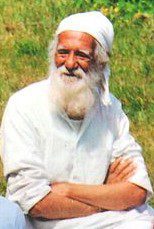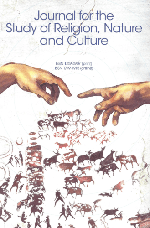In Memory of Sunderlal Bahuguna
The ISSRNC is saddened to note the passing of an important Indian scholar and Himalayan advocate whose work on religion and nature has inspired many over the years. The following short obituary was provided by ISSRNC member David Haberman.

Sunderlal Bahuguna (January 9, 1927 – May 21, 2021) | image credit: Wikipedia
The widely celebrated Indian Himalayan environmentalist Sunderlal Bahuguna passed away from complications due to COVID-19 on May 21st at the age of 94. Throughout his years he was inspired by a philosophy that regarded a sacredness in all natural entities and a worshipful attitude toward what he called “Nature.” Born in the central Himalayas near the town of Tehri, he joined Gandhi’s fight for freedom from British colonial rule in 1940 at the age of 13. After independence he became in involved in Gandhi’s constructive efforts for Himalayan villages, which opened his eyes to the importance of the environment—particularly the forests. As a result, he became a founding pioneer of the Indian environmental movement and major spokesperson for what became the internationally renowned Chipko (“tree-hugging”) movement in which villagers—mostly women—embraced trees to prevent them from being cut down by outside commercial loggers. This movement eventually led to a governmental ban on the commercial logging of trees in the Indian Himalayas above an altitude of 1000 meters. Chipko was also a labor movement, as Bahuguna argued that local residents were the best caretakers of the forests. He dedicated his life to educating people about the importance and fragility of the vital Himalayan ecosystems, walking across the entire Indian Himalayan range to spread his message of local empowerment and environmental protection.
Bahuguna was also laudably outspoken about the kind of development model that was rapidly taking over this region, as well as in other parts of India and globally. Having lost much of their forests to commercial exploitation, Himalayan villagers faced new external forces seeking their other abundant resource—water. Bahuguna with his wife, Vimala Devi, led a mass movement to oppose the construction of the colossal Tehri Dam across the Ganges River that would displace thousands of local residents and posed a serious risk in the likely event of an earthquake in this seismically active area. Bahuguna’s activism conjoined ecological sciences, insights from Indian religious traditions, and Gandhian compassionate non-violence. He underwent several long fasts to protest this dam that he viewed as life-threatening in a number of ways. What I remember most about him when I interviewed him in the year 2000 while we sat near a small shrine honoring Ganga Devi, the goddess of the Ganges, at the center of his vegetable and flower garden just outside the door of his hut perched precariously below the menacing dam was his charming smile and energetic spirit. Although the Chipko movement did successfully gain the attention of the Indian government, the anti-dam movement ended in defeat and the Tehri Dam was completed. This was a major blow to Bahuguna, who regarded the Ganges as his “mother.” When the gates of the Tehri Dam were closed toward the end of 2001, he shaved his head and performed a death ritual for Mother Ganges. On his own death bed, Bahuguna is reported to have asked that people not mourn him, but carry on his efforts to save the Himalayas.
David L. Haberman
Indiana University












